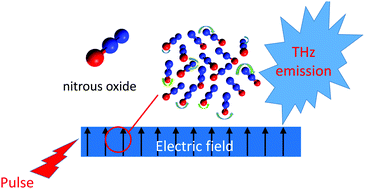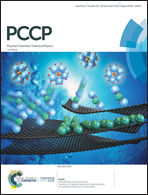Librating dipoles as a probe of spontaneously electrical films and as a source of THz radiation
Abstract
Pulsed electrical excitation of films, composed of spontaneously oriented dipolar molecules, is predicted to cause libration of the constituent species about their fixed lattice sites, accompanied by an oscillating surface potential and emission of THz radiation. We focus on a 100 monolayer (ML) film of nitrous oxide, deposited at 53.5 K, containing oriented dipoles which sustain a spontaneous field of 4.77 × 107 V m−1 and an associated surface potential of 1.386 V. An external field of 108 V m−1, applied to the film, perturbs the angle of dipole orientation by ∼0.95°. Rapid removal of this field causes the dipoles to librate about their steady state orientation. The surface potential oscillates accordingly with a peak-to-peak amplitude of 0.587 V and a frequency of 2.090 THz. The librational motion of the dipoles generates 1.409 μW of THz power per cm2 of substrate, in 4π sr, composed of short bursts of radiation, at a repetition frequency of 4.181 THz. This power may be generated effectively continuously if the perturbing field is applied at a frequency of a few kHz. Observation of the amplitude and time structure of oscillatory surface potentials and of THz emission may potentially provide new and general probes of the spontelectric state, allowing direct observation of hindered molecular rotation and revealing the range of angles of dipole orientation in the crystalline environment.



 Please wait while we load your content...
Please wait while we load your content...